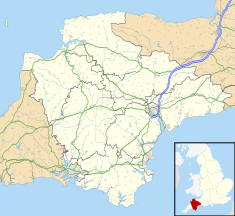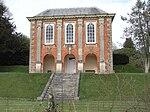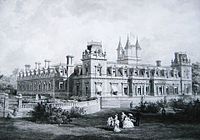Clemson
Lord Clinton sold Stevenstone by auction in 1912 to Captain John Oliver Clemson (1882–1915) and his wife Mary McKinnon, a wealthy heiress. [30] Clemson was born 30 May 1882 in Crumpsall, Manchester the elder son of John Henry Clemson (1856–1889) of Parkside, Altrincham, Cheshire by his wife Sara Jane Oliver (b. 1855). [31] [32] He had one brother and four sisters.
In 1891 aged 8 he was living with his widowed mother at Brookfield House, Bury Old Road, Broughton, Salford. He attended Windermere College Preparatory School, in the parish of St Mary's Church Applethwaite, Windermere, in which church his name appears on a memorial tablet "Boys of the Old College who fell in the Great War". He later attended Sedbergh School between 1897 and July 1900. In the 1901 census he was residing at Red House, Windermere, as a boarder in a preparatory school with three other pupils. He matriculated at Exeter College, Oxford in 1901. He described himself in about 1909 as a "Gentleman farmer of Peagham (Barton), Torrington", which was one of the farms of the Stevenstone estate, about 3/4 mile north of Stevenstone House. On 10 July 1909 he applied for a commission in the Royal North Devon Hussars, and was commissioned as Second Lieutenant on 17 July 1909.
In 1911, unmarried and aged 28, he was staying at Bydown House, Swimbridge, near Barnstaple, as a guest of Robert Jameson and his wife Margaret (née McKinnon), who was the brother-in-law of Mary McKinnon, also then residing in the house, aged 28 and born in Calcutta, Clemson's future wife. [33] In 1912 at Paddington, London, he married Mary McKinnon, 3rd daughter of the late John McKinnon of 10 Hyde Park Gardens, London. They had one daughter. The new owners demolished about half of the east front of the house including the main tower and one corner tower, to make it more manageable, presumably due to the war-time lack of domestic staff. He was Master of the Stevenstone Foxhounds.
Captain Clemson was mobilised on 4 August 1914 and sailed for Gallipoli on 24 September 1914, as part of the South Western Mounted Brigade, during which campaign he died from wounds on 9 December 1915. [34] He is remembered by a monument in St Giles' Church inscribed as follows: "In Loving Memory of John Oliver Clemson, of Stevenstone, Captain Royal North Devon Hussars, who was killed in action in Gallipoli 9th December 1915, aged 33. A great and glorious thing it is to die for one's country". He is recorded on the Exeter College, Oxford Roll of Honour, [34] and also on the Altrincham & District Roll of Honour. [33]
His widow Mary erected a bronze memorial tablet in the church naming the twelve men of the parish who had lost their lives in World War I, reported on in the local press thus: "Following the unveiling by Mrs. Clemson, and the dedication by the Vicar (Rev. C. Walker), the "Last Post" and Reveille were sounded on cornets, and the effect was grand in its solemnity. Special hymns and psalms were sung by the choir, and the Vicar based his address on the significance of the memorial". His grave is in the Lala Baba Cemetery in Turkey. [31] Mrs Clemson remarried to Col. B.C. James, 8th Devon Regiment, awarded the DSO on 1 January 1917, and remained at Stevenstone.
Piecemeal disposal
On 26 September 1930 the estate of Stevenstone was offered for sale by auction, including 665 acres. The property was auctioned again in May 1931, but with only 17 acres and was then described as comprising four reception rooms, 27 bed and dressing rooms and eight bathrooms. [35] It failed to sell at £3,000. A further 300 acres were sold separately.
In the summer of 1931 the house and some of the parkland was purchased by Mr George Millman, the tenant of Winscott Barton (the ancient home of Tristram Risdon), by then part of the Stevenstone estate, within the parish of St Giles. [36] He immediately offered it for sale as building materials prior to complete demolition, split into 609 lots. Lot 609 was the residual shell of the house itself after all else had been sold in the previous lots. Mr Millman however changed his intention against selling, but by then the auction could not be stopped. He bought-in as many lots as he could, and the house continued for a few more years, reduced in size again by the demolition of the servants' wing which connected the house to the stable block.
The house was still habitable during World War II as troops were stationed there, namely the Warwickshire Regiment and later American troops. After the war Mr Millman finally sold the house to Mr Melville, who contrary to his stated intention at the time of purchase, proceeded to demolish it. He used much of the stone to convert the stable block into terraced housing and built several smaller houses and bungalows around it and in the former walled kitchen garden.
In 1970 the vestigial ruins of Stevenstone House were purchased by Mr Parnell, who had purchased the Deer Park in the 1931 sale and had built a bungalow next to the ruins. Although the adjacent detached Library Room and the Orangery were granted Grade II* Listing on 4 October 1960, the ruins of Stevenstone House received much later on 16 February 1989 a Grade II Listing, offering them protection from demolition, but they have continued to deteriorate from adverse weather and are as at 2012 totally covered in ivy.















